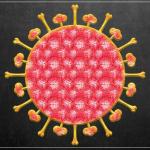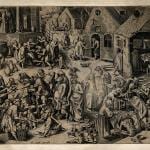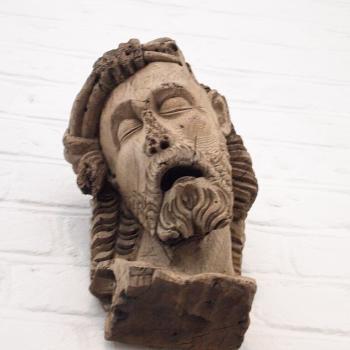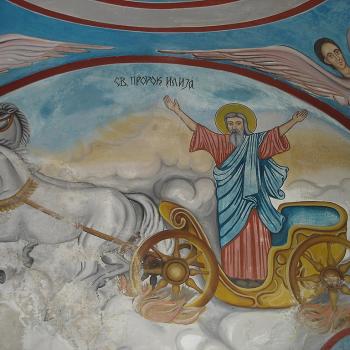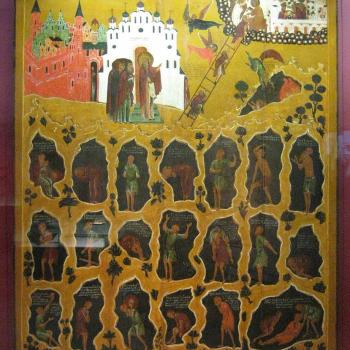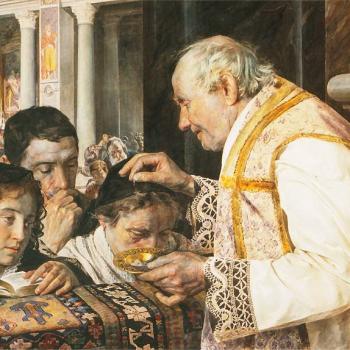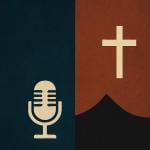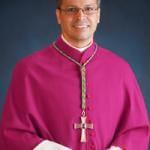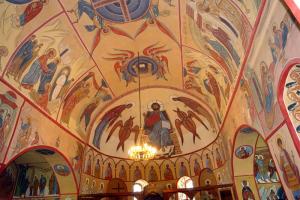
The First Sunday of Lent in the Byzantine cycle is the Sunday of Orthodoxy. This was not always the case. It became associated with Lent because it celebrates the victory of the orthodox teaching on the use of icons against the iconoclasts. That victory occurred on March 11, 843, when a procession brought back icons into Hagia Sophia after a public declaration was made for their use in the first session of a Synod in Constantinople. That event took place the first Sunday of Lent. Since then, the Byzantine tradition commemorates the triumph of orthodoxy represented by the restoration of icons. Previously, the Sunday held a more catechetical significance, as the whole of the Great Fast itself was intended as the time catechumens prepared for baptism. The readings for the feast continue to follow the older, catechetical tradition, emphasizing the way catechumens are being called to receive the new life in Christ on Easter. But the readings not apply only to catechumens; everyone should connect the way Christ called Philip and Nathaniel to follow him with themselves:
The next day Jesus decided to go to Galilee. And he found Philip and said to him, “Follow me.” Now Philip was from Bethsaida, the city of Andrew and Peter.
Philip found Nathanael, and said to him, “We have found him of whom Moses in the law and also the prophets wrote, Jesus of Nazareth, the son of Joseph.” Nathanael said to him, “Can anything good come out of Nazareth?” Philip said to him, “Come and see.” Jesus saw Nathanael coming to him, and said of him, “Behold, an Israelite indeed, in whom is no guile!” Nathanael said to him, “How do you know me?” Jesus answered him, “Before Philip called you, when you were under the fig tree, I saw you.” Nathanael answered him, “Rabbi, you are the Son of God! You are the King of Israel!” Jesus answered him, “Because I said to you, I saw you under the fig tree, do you believe? You shall see greater things than these.” And he said to him, “Truly, truly, I say to you, you will see heaven opened, and the angels of God ascending and descending upon the Son of man” (Jn. 1:43 – 51 RSV).
Since the Great Fast began was a time of preparation for catechumens, much of the discipline and ideas addressed through the time period were meant to introduce catechumens to the basics of the Christian faith. Catechumens were told what kind of moral life they were expected to follow once they became Christian. But there was more than this. They were told what they should expect once they became Christian. They would be partakers of the kingdom of God, as Alexander Schmemann explains:
This means: you catechumens, you who believe in Christ, you who want to be baptized, who are preparing yourselves for Pascha – you shall see the inauguration of the new age, the fulfillment of all promises, the manifestation of the Kingdom. But you shall see it only if you believe and repent, if you change your mind, if you have the desire, if you accept the effort.[1]
Those who were soon to become baptized were told that they were about to receive should not be seen as something cheap and worthless. It comes with expectations. They were to change their ways. And as many come to the faith with and through bad habits, the Great Fast was a time of putting all things aside, of getting control over oneself, so that such habits could be overcome (or at least, put in check, similar to the way an alcoholic puts their own inclinations in check). Christ offers much but also expects much in return. Great things are opened up for us. We shall see the kingdom of God – but only if we remove all the filters which get in its way.
We shall see the kingdom of God. This is exactly what icons help us do. They show in part the kingdom of God to us. They are able to do this because of the incarnation. For through the incarnation, the kingdom of God is revealed, not as something apart from the world, but rather, something which is united to it. Indeed, it is the foundation of the world. Thus, the commemoration of the triumph of orthodoxy should not be seen merely as a remembrance of what happened in 851, but, as Sergius Bulgakov indicates, the promotion of the dogmatic significance of that event:
The first Sunday of the Great Fast, “the Sunday of Orthodoxy,” is dedicated to icon-veneration, celebrated of course not only as a historical remembrance but also in its dogmatic significance. The recognition that Christ can be represented iconographically attests that the God-Man Jesus, uniting two natures in Himself, Divine and Human, has one indivisible image, an image that is not just human, but Divine-Human. [2]
Because God became man, the eschaton has become immanent. Now, God reveals himself to us in a form which we can perceive and use to engage him. Because God became man, the incomprehensible, uncircumscribed God has come to us in a form which can be seen and used to create images. Indeed, as the human body is visible, it has its own image which can be represented in iconographic form. By taking on a human body, God created his own image with that body, an image which we can perceive and embrace and use in our worship of him. Of course, the icons which we make to represent that image is derivative in nature, but yet they realize the truth and demonstrate the kingdom of God to those who know how to view them. We shall see the kingdom of God. Most of us shall see it first in visual representations which others make of their own encounter of it. But hopefully we will have our own personal encounter with it, which we will then be able to use to portray it to others in a variety of ways.
The journey to the kingdom of God, like the journey of Lent, like the way of the cross itself, is often filled with highs and lows. That is, we must understand that the victory of orthodoxy, just like the victory of the resurrection, comes after the cross. There will be struggles. We will have to die to the self. But if we truly follow Christ, if we open ourselves up to him and his grace, then the self-emptying of the cross, our death to the self will lead us to the glory of the kingdom of God and the affirmation of who we can become in Christ. History is full of this kind of struggle; we must push on with faith when we feel everything is standing against us and destroying us, for that is the way we become transformed and able to receive our proper share of the kingdom of God. Thus, the author of the book of Hebrews reminds us:
By faith Moses, when he was grown up, refused to be called the son of Pharaoh’s daughter, choosing rather to share ill-treatment with the people of God than to enjoy the fleeting pleasures of sin. He considered abuse suffered for the Christ greater wealth than the treasures of Egypt, for he looked to the reward (Hebr. 11:12-26 RSV).
Men and women alike struggled and received their share of the glory:
And what more shall I say? For time would fail me to tell of Gideon, Barak, Samson, Jephthah, of David and Samuel and the prophets — who through faith conquered kingdoms, enforced justice, received promises, stopped the mouths of lions, quenched raging fire, escaped the edge of the sword, won strength out of weakness, became mighty in war, put foreign armies to flight. Women received their dead by resurrection. Some were tortured, refusing to accept release, that they might rise again to a better life. Others suffered mocking and scourging, and even chains and imprisonment. They were stoned, they were sawn in two, they were killed with the sword; they went about in skins of sheep and goats, destitute, afflicted, ill-treated — of whom the world was not worthy — wandering over deserts and mountains, and in dens and caves of the earth. And all these, though well attested by their faith, did not receive what was promised, since God had foreseen something better for us, that apart from us they should not be made perfect (Heb. 11:32-39 RSV).
It is easy to think, now that Christ has come, now that the eschaton has entered history, all the preparation is done, and so the pattern will not need be the same. But that is not the case. Rather, the eschaton needs to be realized by all, and in that realization, all need to open themselves up to it, die to themselves, and allow the greater good of the kingdom of God come into them and raise them up in glory.
Every moment dies and must pass over to eternity. In that passing by, history and the eschaton meet. As long as we continue to live in history, we go from moment to moment, with its own death; we must struggle to awaken the eschaton in the union between the moment we live in and eternity. We must allow the glory of the kingdom of God shine through. Nonetheless, because we are still in time, we often falter and do not completely turn over the moment to its eschatological glory. History goes on and the mistakes of the past repeat themselves time and time again. Generation after generation will have to repeat what happened before them. It will often seem that the glory of the kingdom of God is being stamped out on earth before it once again takes light and is revealed in its glory. This is exactly what happened with the triumph of orthodoxy; the iconoclasts appeared to win, and they started to stamp out the representations of the kingdom of God all around them as they destroyed icons wherever they could be found. Then, when it seemed as if all had been lost, the kingdom of God once again rose up and revealed its true glory. Particular icons can be destroyed, but their use would not be abolished. The apparent victory against the kingdom of God only allowed the greatness of the kingdom to be known. And those who were touched by the glory of God would not be silenced forever: they rose up in glory and were able to once again present the glory of the kingdom of God to the world. The grandeur of the kingdom cannot be squashed.
This should give us hope. The cycle of history continues. Victory for one generation is passed down to another, even as those forces of darkness will continue to fight against the kingdom and have apparent victories against the light until the end of the world. The more the light shines, the more the darkness will be revealed. The more the darkness is revealed, the greater the struggle, the greater the apparent defeat before another ray of light shines forth in and through the saints of God.
The victory of the kingdom of God will present what came before it while revealing itself in new and glorious ways – for the grace of God is infinite and can manifest itself in diverse forms in the world. This means it will continue with what came before it without being legalistically attached to its previous forms. The victory of the iconophiles over the iconoclasts demonstrates this: early Christians did not fully appreciate images, even if they did not entirely deny their use for the Christian faith. Some feared images could lead to idolatry and suggested spiritualities which transcended images. But they still kept the basic premises of icons intact, and this was able to bring forth the new movement of the kingdom of God in the way the Christian laity embraced and used icons. It continued on with the theological teaching of the kingdom of God. Then it revealed itself in full glory as the struggle against the iconoclasts ended, icons were embraced, and the glory of God was seen in them, attracting many new people to the faith.
Likewise, then, when the church finds itself struggling, its apparent light diminishing with moral failure, we must struggle with Christ, follow the path of the cross, allowing things to be taken down around us, so that then the glory of God can once again come to us and lift us up to where we need to be to meet today’s needs. The triumph of orthodoxy tells us to have faith in the kingdom of God, so that every time the darkness seems to overtake the light, we know the light will shine brighter, giving us new means to embrace it and share it with the world. It is not just the catechumens who are called, but everyone; let us heed the call so that we too can see the glory of the kingdom of God and reveal it to the world.
[1] Alexander Schmemann, Great Lent: Journey to Pascha (Crestwood, NY: 1969; rev. ed., 1974), 74-5.
[2] Sergius Bulgakov, Churchly Joy: Orthodox Devotions for the Church Year. trans. Boris Jakim (Grand Rapids, MI: William B. Eerdmans Publication, 2008), 76.
Stay in touch! Like A Little Bit of Nothing on Facebook.
If you liked what you read, please consider sharing it with your friends and family!


